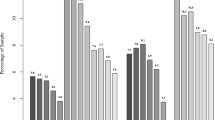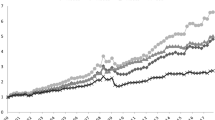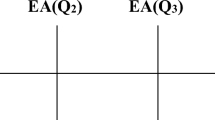Abstract
This paper investigates alternative models of learning to explain changes in uncertainty surrounding earnings innovations. As a proxy for investor uncertainty, we use model-free implied volatilities; as a proxy for earnings innovations, representing signals of firm performance likely to drive investor perceptions of uncertainty, we use quarterly unexpected earnings benchmarked to the consensus forecast. We document that uncertainty declines on average after the release of quarterly earnings announcements and this decline is attenuated by the magnitude of the earnings innovation. This latter result is consistent with models that incorporate signal magnitude as a factor driving changes in uncertainty. Most important, we document that signals deviating sufficiently from expectations lead to net increases in uncertainty. Critically, this result suggests that models allowing for posterior variance to be greater than prior variance even after signal revelation [e.g., regime shifts in Pastor and Veronesi (Annu Rev Financ Econ 1:361–381, 2009)] better describe how investors incorporate new information.


Similar content being viewed by others
Notes
Throughout the manuscript, we use the terms “magnitude” and “size” interchangeably, to capture a measurement property of the signal. In such models, signals are benchmarked to some prior expectation preceding the signal’s release.
Following the results of Black and Scholes (1973), we use the terms “increase (decrease) in implied volatility,” “increase (decrease) in uncertainty about future firm value,” and “increase (decrease) in uncertainty about future realized returns” interchangeably.
If the system evolves linearly like in a dynamic linear model, the prior uncertainty will be higher before the signal is received compared to the posterior variance after receiving the signal, and the posterior variance is not affected by the absolute size of the innovation (West and Harrison 1997, Chapter 3).
Subramanyam (1996) presents a single-period model that uses a similar mathematical structure. However, without modifications, this type of model will eventually resolve all uncertainty; this appears inconsistent with market data.
∆VIX (measured using the values of days −4 and +4) may appear inconsistent with our calculation of IVOL_365 (which is averaged across days −5 to −3, and days +3 to +5). As discussed below, we use averages for IVOL_365 to minimize the effects of noise upon this firm-level construct. For the change in the macro-level measure of volatility (∆VIX), the effects of noise are likely much less severe. Indeed, the correlation for our definition of ∆VIX and an alternative measure using days −5 to −3 and days +3 to +5 exceeds 94 %. Not surprisingly, our results are unchanged to using this alternative definition of ∆VIX.
A constant implied volatility measures the next n days of volatility and thus is not tied to any traded option maturity. Restated, a constant 30-day maturity volatility measured at time t measures the forecasted volatility from t to t + 30, and at time t + 1, the 30-day maturity volatility measures the forecasted volatility from t + 1 to t + 31. Thus the length of maturity is held constant.
In the Heston (1993) option pricing model, the total variance of a stock is determined by (1) the current variance, (2) the long-term variance, and (3) the mean reversion rate. The shape of the implied volatility smile or smirk observed in the market, however, is determined by the “vol-of-vol” and correlation between stock and variance movements. Thus two stocks may actually have different ATM volatilities but have the same expected variance if they have the same values for the first set of parameters but different values for the second set. If, for example, two stocks had the same value for the first three parameters then the stock with the higher vol-of-vol parameter would have a lower ATM implied volatility but higher OTM implied volatilities, in general.
One example is Sridharan (2015), who uses a limited sample of model-free volatilities as a robustness check.
Note that we do replicate our primary analyses using shorter-term (30- and 60-day) option maturities. Consistent with our above discussion, we provide evidence consistent with attenuation (H1) but fail to find evidence of net volatility increases (H2). Again, this is expected, as such short-maturity options do not incorporate expectations of future earnings (i.e., signal) realizations, which is critical to our assessment of these Bayesian learning models. That is, these models center on investor learning about expected volatility with respect to future signal realizations.
The correlation between the two experimental variables is 0.498, suggesting these capture similar but not overlapping, notions of earnings innovations.
Specifically, when scaling by the mean absolute earnings forecast, we (1) first identify the mean analyst forecasts, (2) take the absolute value of these means, (3) delete firm-quarters for which the absolute forecast is <$0.01/share (to avoid small denominator effects), and (4) then scale absolute unexpected earnings.
Note that the interaction of LEV × SUE includes the signed earnings announcement, while our experimental variable Abs_SUE is unsigned. This is intentional and consistent with theory underlying the inclusion of the respective variables. Specifically, signed earnings has a direct effect on leverage and thus is appropriate to use when assessing the effect of leverage on uncertainty. In contrast, the effect on uncertainty under Bayesian updating is not conditioned on the sign of the signal. Note that the Merton (1974) model of leverage suggests that a firm with no leverage should not see a change in its volatility due to a change in its asset value. Furthermore, we do not use the stock return as a proxy for the size of the surprise, as uncertainty/volatility and stock prices are jointly determined.
To further control for pre-announcement uncertainty, we also estimate a regression including as an additional control variable, %REVISIONS. This is measured as the number of analysts revising earnings forecasts in the five (or alternatively, 10) days preceding the earnings announcement, divided by the total number of analysts issuing earnings forecasts. The resulting coefficients on %REVISIONS are generally negative, indicating that firms with more analyst activity before an earnings announcement have more uncertainty resolved by the announcement. However, results on all other variables are unchanged by the inclusion of %REVISIONS.
Results are robust to alternative definitions of size, including the natural log of equity market capitalization.
We do not tabulate these analyses with alternative leverage proxies, as they resemble those presented. However, the results are available upon request.
Note that we do not conduct sensitivity analyses incorporating temporal fixed effects into Tables 4 and 5. This is because the research design for both tables relies on mean (intercept) shifts; thus (for example) inclusion of time fixed effects would preclude using the intercept to assess the mean change in uncertainty for firms having average values of each of the control variables. However, results are robust to alternatively clustering by reporting quarter and firm.
The coefficient on Abs_SUE in Table 3 is significant and positive when using price as the scalar in both the expansionary and recessionary periods.
In addition, the interaction term Abs_SUE x VIX is negative and significant when added to the column (1) and column (2) models of Table 3.
However, we do note that unscaled absolute forecast error and dispersion are positively correlated with equity price in our sample.
The delta of an option is the partial derivative of the option’s price to the underlying’s price.
There is also a precedent for using only at-the-money and out-of-the-money options in academic studies. Carr and Wu (2010) state: “Since out-of-the money options are more actively traded than in-the-money options, the quotes on out-of-the-money options are usually more reliable.”
References
Bailey, W., Karolyi, G., & Salva, C. (2006). The economic consequences of increased disclosure: Evidence from international cross-listings. Journal of Financial Economics, 81, 175–213.
Barron, O., Kim, O., Lim, S., & Stevens, D. (1998). Using analysts’ forecasts to measure properties of analysts’ information environment. The Accounting Review, 73, 421–433.
Barth, M., & So, E. (2014). Non-diversifiable volatility risk and risk premiums at earnings announcements. The Accounting Review, 89, 1579–1607.
Billings, M., Jennings, R., & Lev, B. (2014). On guidance and volatility. Working paper, Indiana University and New York University.
Black, F. (1976). Studies of stock price volatility changes. In Proceedings of the business and economics section of the American Statistical Association (pp. 177–181).
Black, F., & Scholes, M. (1973). The pricing of options and corporate liabilities. Journal of Political Economy, 81, 637–654.
Britten-Jones, M., & Neuberger, A. (2000). Option prices, implied price processes, and stochastic volatility. Journal of Finance, 55, 839–866.
Brown, L., & Han, J. (1992). The impact of annual earnings announcements on convergence of beliefs. The Accounting Review, 67, 862–875.
Carr, P., & Madan, D. (1998). Towards a theory of volatility trading. In R. A. Jarrow (Ed.), Volatility: New estimation techniques for pricing derivatives (pp. 417–427). London: Risk Books.
Carr, P., & Wu, L. (2009). Variance risk premiums. Review of Financial Studies, 22, 1311–1341.
Carr, P., & Wu, L. (2010). Stock options and credit default swaps: A joint framework for valuation and estimation. Journal of Financial Econometrics, 8, 409–449.
Chen, C., Lu, H., & Sougiannis, T. (2012). The agency problem, corporate governance, and the asymmetrical behavior of selling, general, and administrative costs. Contemporary Accounting Research, 29, 252–282.
Cheong, F., & Thomas, J. (2011). Why do EPS forecast error and dispersion not vary with scale? Implications for analyst and managerial behavior. Journal of Accounting Research, 49, 359–401.
Christie, A. (1982). The stochastic behavior of common stock variances: Value, leverage and interest rate effects. Journal of Financial Economics, 10, 407–432.
Das, S., Levine, C., & Sivaramakrishnan, K. (1998). Earnings predictability and bias in analysts’ earnings forecasts. The Accounting Review, 73, 277–294.
Demeterfi, K., Derman, E., Kamal, M., & Zou, J. (1999). A guide to volatility and variance swaps. Journal of Derivatives, 6, 9–32.
Demsetz, D., & Lehn, K. (1985). The structure of corporate ownership: causes and consequences. Journal of Political Economy, 93, 1155–1177.
Duffie, D., Pan, J., & Singleton, K. (2000). Transform analysis and asset pricing for affine jump-diffusions. Econometrica, 68, 1343–1376.
Echambadi, R., & Hess, J. (2007). Mean-centering does not alleviate collinearity problems in moderated multiple regression models. Marketing Science, 26, 438–445.
Gatheral, J. (2004). A parsimonious arbitrage-free implied volatility parameterization with application to the valuation of volatility derivatives. Presentation at Global Derivatives & Risk Management, Madrid, May 2004. http://faculty.baruch.cuny.edu/jgatheral/madrid2004.pdf.
Gatheral, J., & Jacquier, A. (2011). Convergence of Heston to SVI. Quantitative Finance, 11, 1129–1132.
Gatheral, J., & Jacquier, A. (2012). Arbitrage-free SVI volatility surfaces. Quantitative Finance, 14, 59–71.
Greene, W. (1993). Econometric analysis (3rd ed.). Upper Saddle River, NJ: Prentice Hall.
Gu, Z., & Chen, T. (2004). Analysts’ treatment of nonrecurring items in street earnings. Journal of Accounting and Economics, 38, 129–170.
Heston, S. (1993). A closed-form solution for options with stochastic volatility with applications to bond and currency options. Review of Financial Studies, 6, 327–343.
Holthausen, R., & Verrecchia, R. (1990). The effect of informedness and consensus on price and volume behavior. The Accounting Review, 65, 191–208.
Hong, H., & Kubik, J. (2003). Analyzing the analysts: Career concerns and biased earnings forecasts. Journal of Finance, 58, 313–351.
Isakov, D., & Perignon, C. (2001). Evolution of market uncertainty around earnings announcements. Journal of Banking & Finance, 25, 1769–1788.
Jiang, G., & Tian, Y. (2005). The model-free implied volatility and its information content. Review of Financial Studies, 18, 1305–1342.
Kothari, S. (2001). Capital market research in accounting. Journal of Accounting and Economics, 31, 105–231.
Lang, M., & Lundholm, R. (1996). Corporate disclosure policy and analyst behavior. The Accounting Review, 71, 467–492.
Lewellen, J., & Shanken, J. (2002). Learning, asset pricing, and market efficiency. Journal of Finance, 58, 1749–1789.
Liang, L., & Riedl, E. (2014). The effect of fair value versus historical cost reporting model on analyst forecast accuracy. The Accounting Review, 89, 1151–1177.
Merton, R. (1974). On the pricing of corporate debt: the risk structure of interest rates. Journal of Finance, 29, 449–470.
Morse, D., Stephan, J., & Stice, E. (1991). Earnings announcements and convergence (or divergence) of beliefs. The Accounting Review, 66, 376–388.
Nelder, J., & Mead, R. (1965). A simplex method for function minimization. Computer Journal, 7, 308–313.
Pastor, L., & Veronesi, P. (2003). Stock valuation and learning about profitability. Journal of Finance, 58, 1749–1789.
Pastor, L., & Veronesi, P. (2006). Was there a NASDAQ bubble in the late 1990s? Journal of Financial Economics, 81, 61–100.
Pastor, L., & Veronesi, P. (2009). Learning in financial markets. Annual Review of Financial Economics, 1, 361–381.
Patell, J., & Wolfson, M. (1979). Anticipated information releases reflected in call option prices. Journal of Accounting and Economics, 1, 117–140.
Patell, J., & Wolfson, M. (1981). The ex ante and ex post price effects of quarterly earnings announcements reflected in option and stock prices. Journal of Accounting Research, 19, 434–458.
Rogers, J., Skinner, D., & Van Buskirk, A. (2009). Earnings guidance and market uncertainty. Journal of Accounting and Economics, 48, 90–109.
Schwert, G. W. (1989). Why does stock market volatility change over time? Journal of Finance, 44, 1115–1153.
Skinner, D. (1990). Option markets and the informational content of accounting earnings releases. Journal of Accounting and Economics, 13, 191–211.
Sridharan, S. (2015). Volatility forecasting using financial statement information. The Accounting Review, 90, 2079–2106.
Subramanyam, K. (1996). Uncertain precision and price reaction to information. The Accounting Review, 71, 207–219.
Timmermann, A. (1993). How learning in financial markets generates excess volatility and predictability of stock returns. Quarterly Journal of Economics, 108, 1135–1145.
Verrecchia, R. (1983). Discretionary disclosure. Journal of Accounting and Economics, 5, 179–194.
Welch, I. (2011). Two common problems in capital structure research: the financial debt-to-asset ratio and issuing activity versus leverage changes. International Review of Finance, 11, 1–17.
West, M., & Harrison, J. (1997). Bayesian forecasting and dynamic models (2nd ed.). New York: Springer.
Zhang, Y., Taylor, S., & Wang, L. (2012). Investigating the information content of the model-free volatility expectation by Monte Carlo methods. Journal of Futures Markets, 33, 1071–1095.
Acknowledgments
We appreciate useful comments and discussions on prior versions of this paper from Russell Lundholm (editor), an anonymous reviewer, Ana Albuquerque, Rui Albuquerque, Bill Baber, Zhaoyang Gu, Yen-Jung Lee, Lynn Li, Suming Lin, Chi-Chun Lui, Krish Menon, Michael Smith, Shu Yeh, Linhui Yu, Julie Zhu, and workshop participants at Boston University, Chinese University of Hong Kong, George Mason University, George Washington University, and National Taiwan University. The U.S. Securities and Exchange Commission, as a matter of policy, disclaims responsibility for any private publication or statement by any of its employees. The views expressed herein are those of the author and do not necessarily reflect the views of the commission or of the author’s colleagues on the staff of the commission.
Author information
Authors and Affiliations
Corresponding author
Rights and permissions
About this article
Cite this article
Neururer, T., Papadakis, G. & Riedl, E.J. Tests of investor learning models using earnings innovations and implied volatilities. Rev Account Stud 21, 400–437 (2016). https://doi.org/10.1007/s11142-015-9348-5
Published:
Issue Date:
DOI: https://doi.org/10.1007/s11142-015-9348-5




